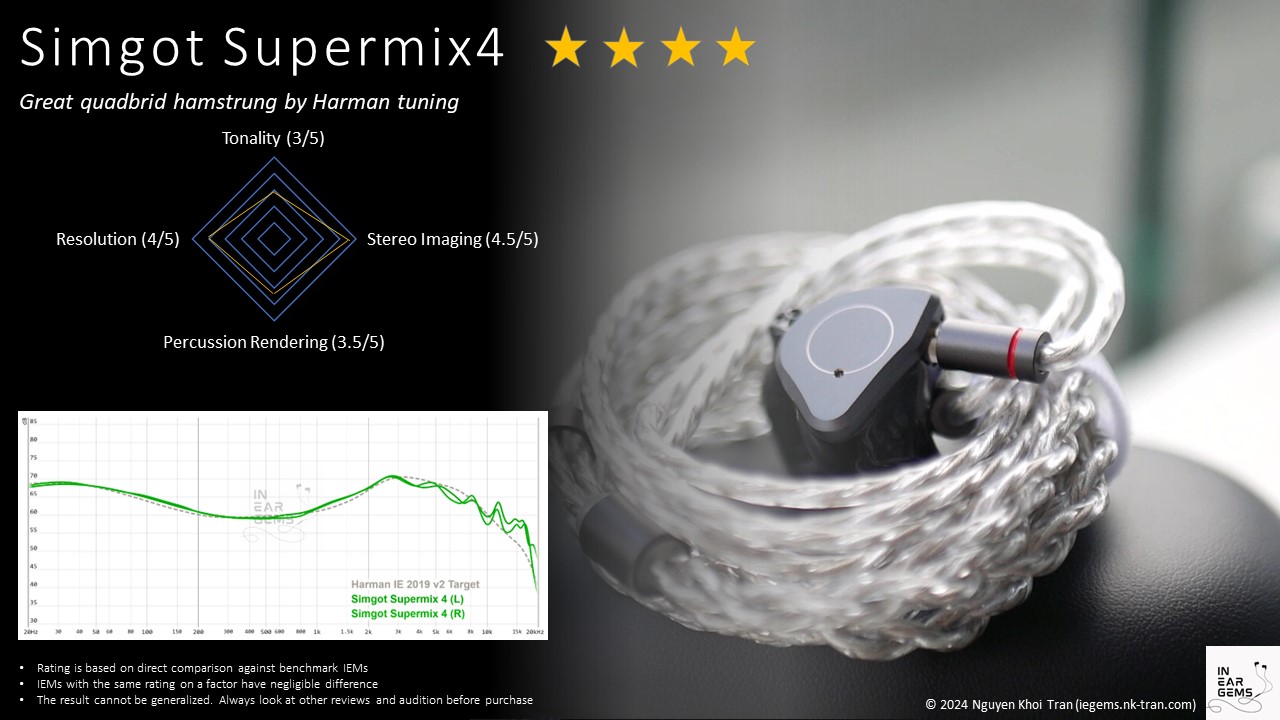Simgot Supermix4 - Great quadbrid hamstrung by Harman tuning
I’ve always considered “quadbrid” IEMs - those that combine four types of drivers - to be my personal “holy grail” IEMs. No, I’m not suggesting that an IEM automatically sounds phenomenal just because it has a quadbrid or tribrid configuration. What these IEMs possess is immense potential to be mind-blowing if manufacturers can overcome the seemingly insurmountable challenges of making various types of drivers perform at their full potential while working together cohesively to create a unified sound signature.
Due, in part, to the complexity involved, tribrid and quadbrid IEMs rarely reach their promised potential and are almost never affordable. This is why I was quite curious about Simgot’s attempt to release a quadbrid IEM at $135. Finally, I managed to get my mitts on one of these snazzy Supermix4. Are they any good? Let’s discuss one of the most budget-friendly quadbrid IEMs available in today’s market.
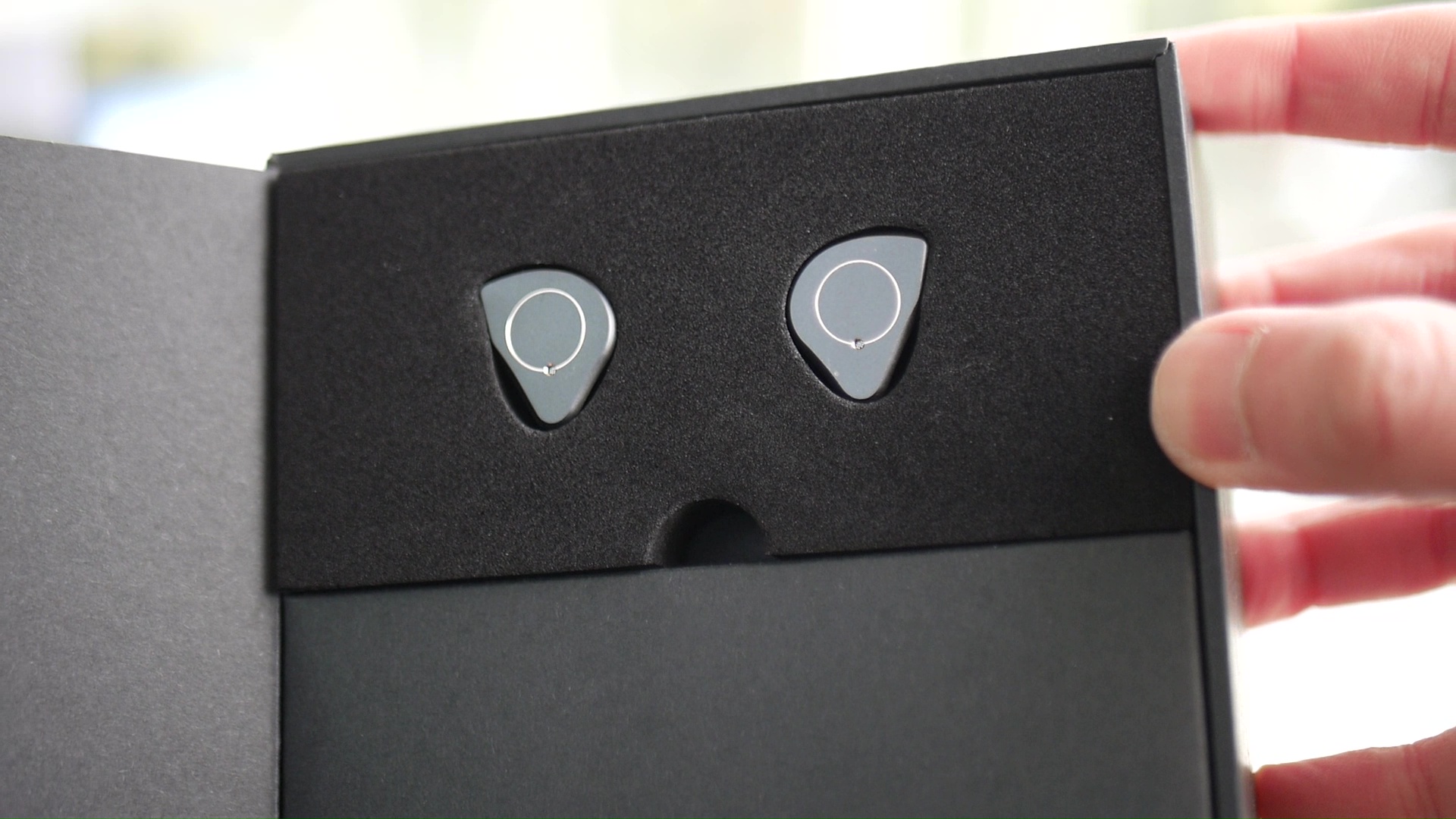
Forewords
- What I look for in an IEM is immersion. I want to feel the orchestra around my head, track individual instruments, and hear all of their textures and details. I’m not picky about tonality, as long as it is not make the orchestra, violin, cellos, and pianos sound wrong.
- I rate IEMs within with a consistent scale from 1 (Poor) to 3 (Good) to 5 (Outstanding). An overall ranking of 3/5 or above is considered positive.
- Ranking list and measurement database are on my IEM review blog.
- The terminology for subjective impressions in this review is based on the Audio Wheel for reproduced sound defined in the technical report ITU-R BS.2399-0
- This review is based on a review sample from Simgot (Thank you Betty @ Simgot!). I have no affiliation with or financial interest in Simgot.
- The unit retails for $134.9 at the time this review was published. Unaffiliated link: Linsoul
General Information
One aspect I enjoy exploring in an IEM review is delving into the underlying technology. Simgot’s IEMs are always fascinating to examine (refer to my previous review of EA1000). So, sit back and grab a cup of your favorite beverage as we dive into the technical details. It’s going to be a long one.
The Supermix4 features a quadbrid driver configuration consisting of a 10mm dynamic driver (DD), one balanced armature (BA) driver, one planar driver, and one piezoelectric (PZT) transducer. The IEM employs a 4-way electronic crossover and independent sound tubes for each driver to regulate their behavior.
Firstly, let’s examine the 10mm DD. This driver utilizes a flexible surround/suspension system that enables a long-stroke design (in simple terms, the diaphragm moves back and forth over a longer distance than usual for a stiffer diaphragm design). Most IEMs with this type of DD that I’ve tested exhibit a pleasing “bouncy” sensation in the bass region.
Moving on to the BA driver, information is scarce, possibly due to its less exciting technology. As far as I can gather, the BA driver is a large, full-range driver rather than a small one focusing solely on the midrange frequency.

The high frequencies are where Supermix4’s technology is truely interesting. These are managed by both a micro planar driver and the PZT driver. The micro planar driver in question is similar to the “rectangular” variety found in Astell & Kern Zero 1 and Zero 2 IEMs, rather than the circular micro planar drivers seen in Kinera and Celest models. While there isn’t much more to say about these planar drivers, they do produce nicely detailed treble.
The PZT driver piqued my interest due to its placement on the shells and operation, which bears a striking resemblance to the so-called “bone conduction drivers” in the famous quadbrid IEMs from the MEST family by audio boutique Unique Melody. Simgot informed me that this PZT driver is responsible for filling in the upper treble by vibrating the entire shell from behind the faceplate. While they don’t label it as a “bone conduction driver,” I do perceive the desired holographic effect with certain tracks in my library.
Non-sound Aspects
Packaging and accessories Supermix4 has smaller box, but its appearance is rather striking. I like the X-ray photo of the IEM on the front of the box, showing the placement of the driver sound tubes, and crossover circuit. Inside the box, you find the usual black-and-gold design motif of Simgot. However, I must say I’m rather disappointed that I don’t see the usual slogan “Salute to Art and Science”, nor an interesting theme like Fermat’s last theorem with the EA1000. The codename “Supermix4” is also not as cool as “Fermat” and “Boson”.
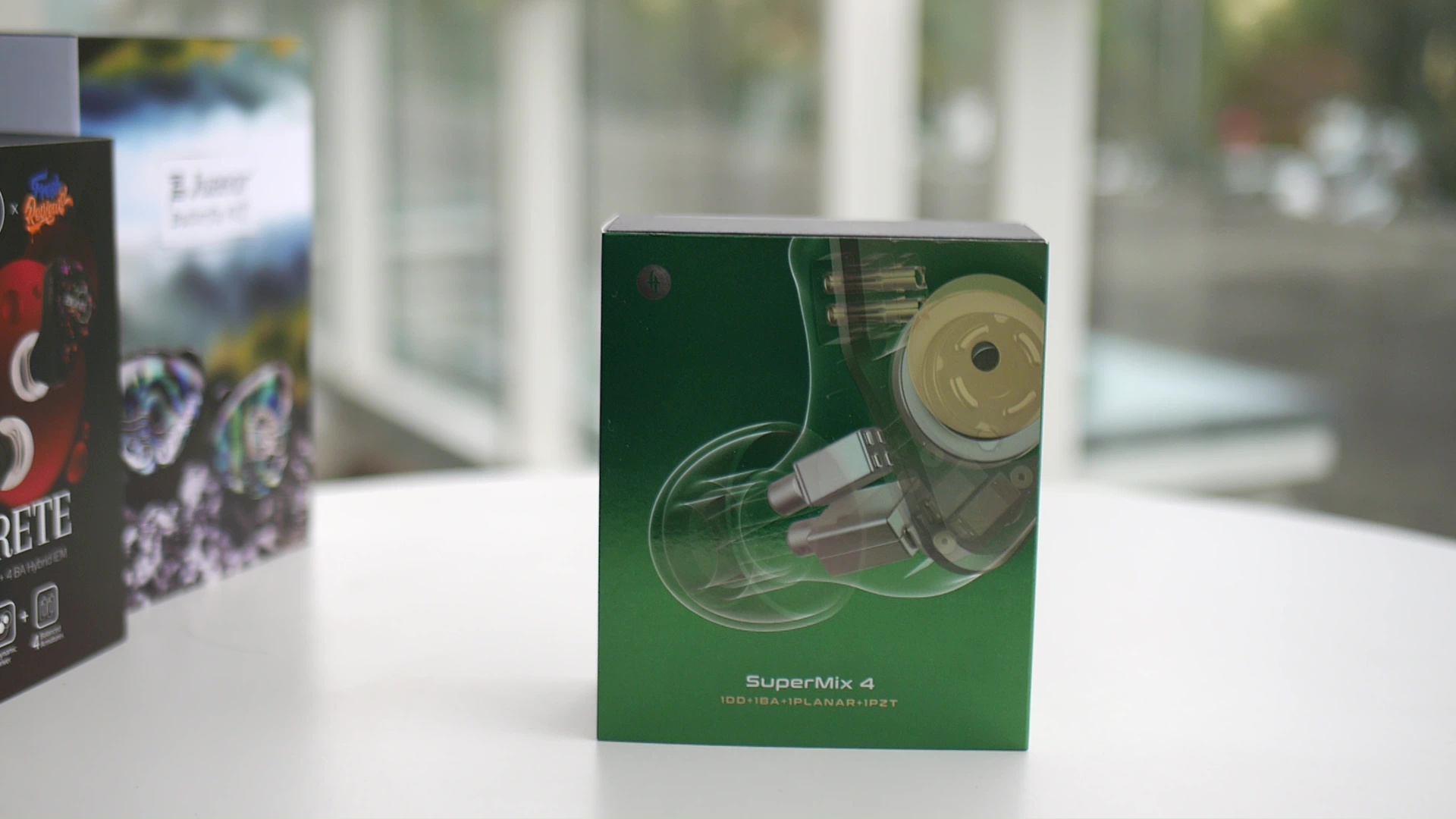
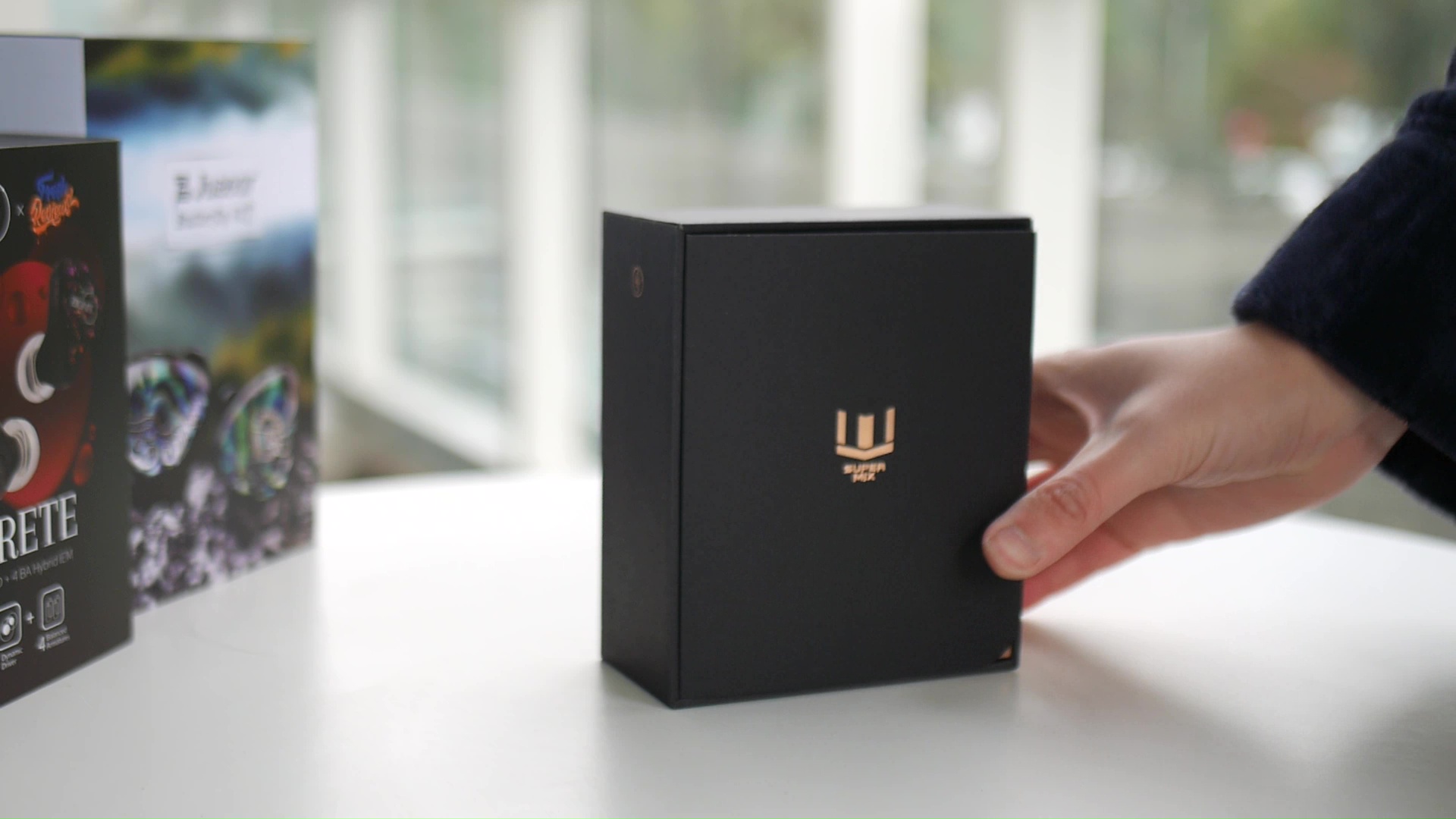
Accessories wise, simgot supplies supermix4 with a functional accessories set but rather sparse. In the box you find a cable (mine comes with 3.5mm termination), a zippered case, one set of wide-bored thick core silicone tips.
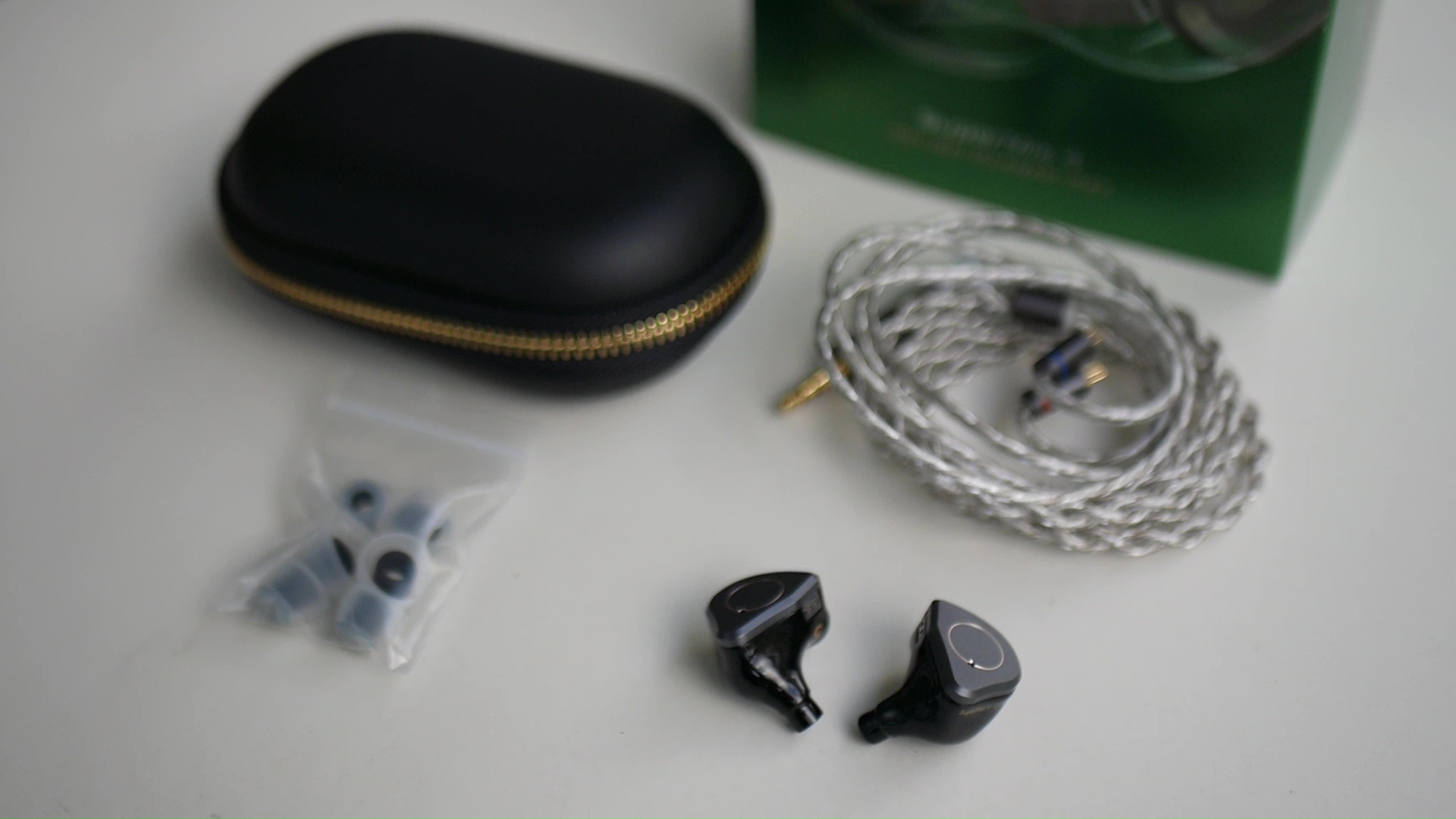
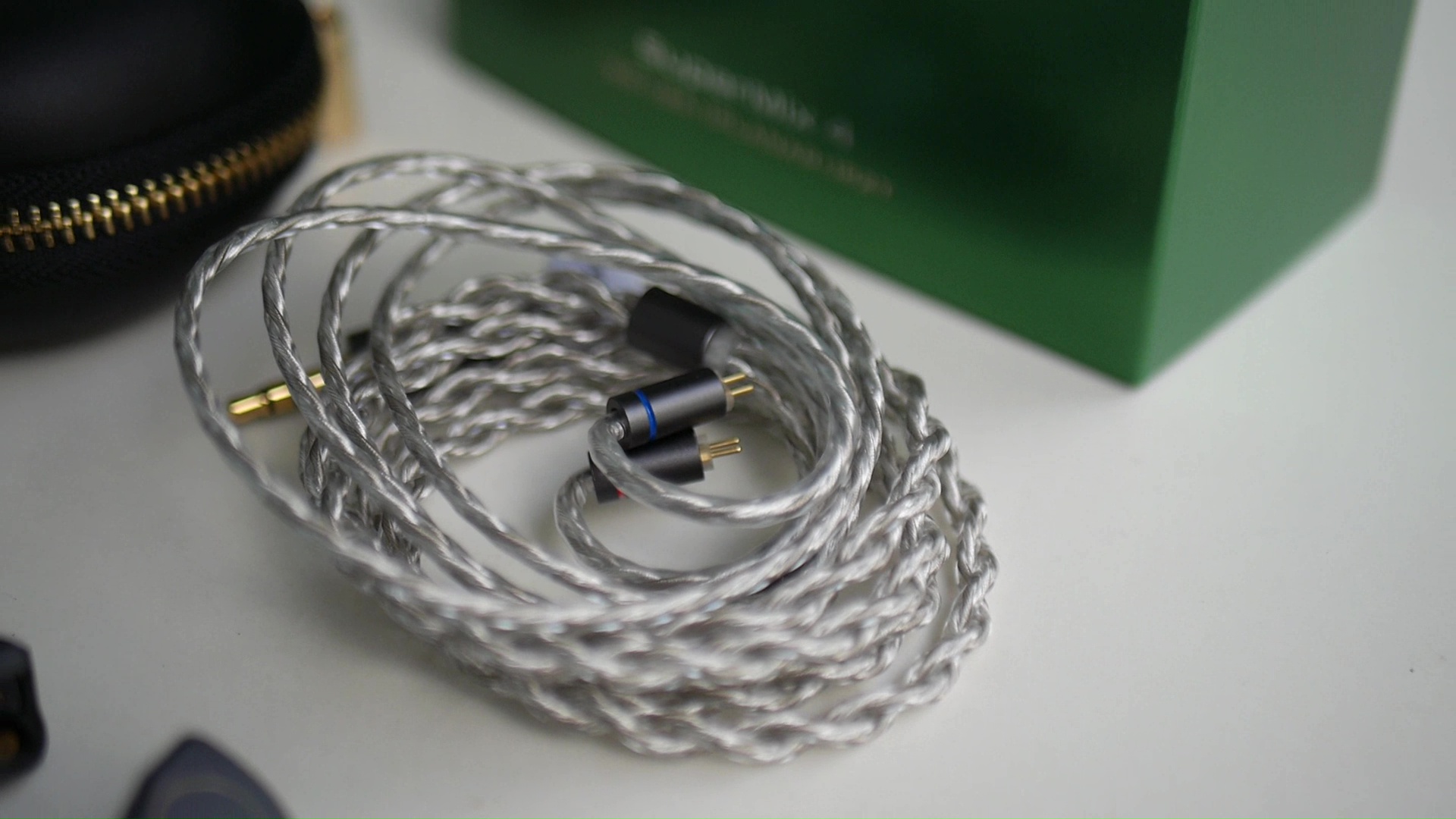

Ear pieces design Supermix4 earpieces are on the smaller end of the spectrum, similarly to most other IEMs from simgot. The design is rather simplistic, but not completely dull thanks to the golden ring framing the PZT driver on the faceplate. The nozzles are medium in size and length, with good angle.

Fit, comfort and isolation I found supermix4 to be very comfortable with the right ear tips. Noise isolation is average. I notice that on busses, the lower frequencie of supermix4 is quite drown out by the rumble of the bus, making the IEM sounds a bit harsh in these environment.



Ear tips recommendation: I recommend softer ear tips so that you can fit these IEMs deeper. Ideally, you want to ensure that the ears have as much contact surface with the earpieces as possible. I opt for Velvel medium ear tips for my tests.
Sonic Performance
Testing setup:
- Sources: iBasso DX300, HiBy R3II, L&P W4, FiiO K7
- Cable: NiceHck Black Cat with 4.4mm termination
- Ear tips: Velvet medium
The subjective impression is captured using the lexicon in the Sound Wheel below. I’ll clarify the terminology as I use them. If you want to see more details of the lexicon and related reference, please have a look at the technical report ITU-R BS.2399-0.
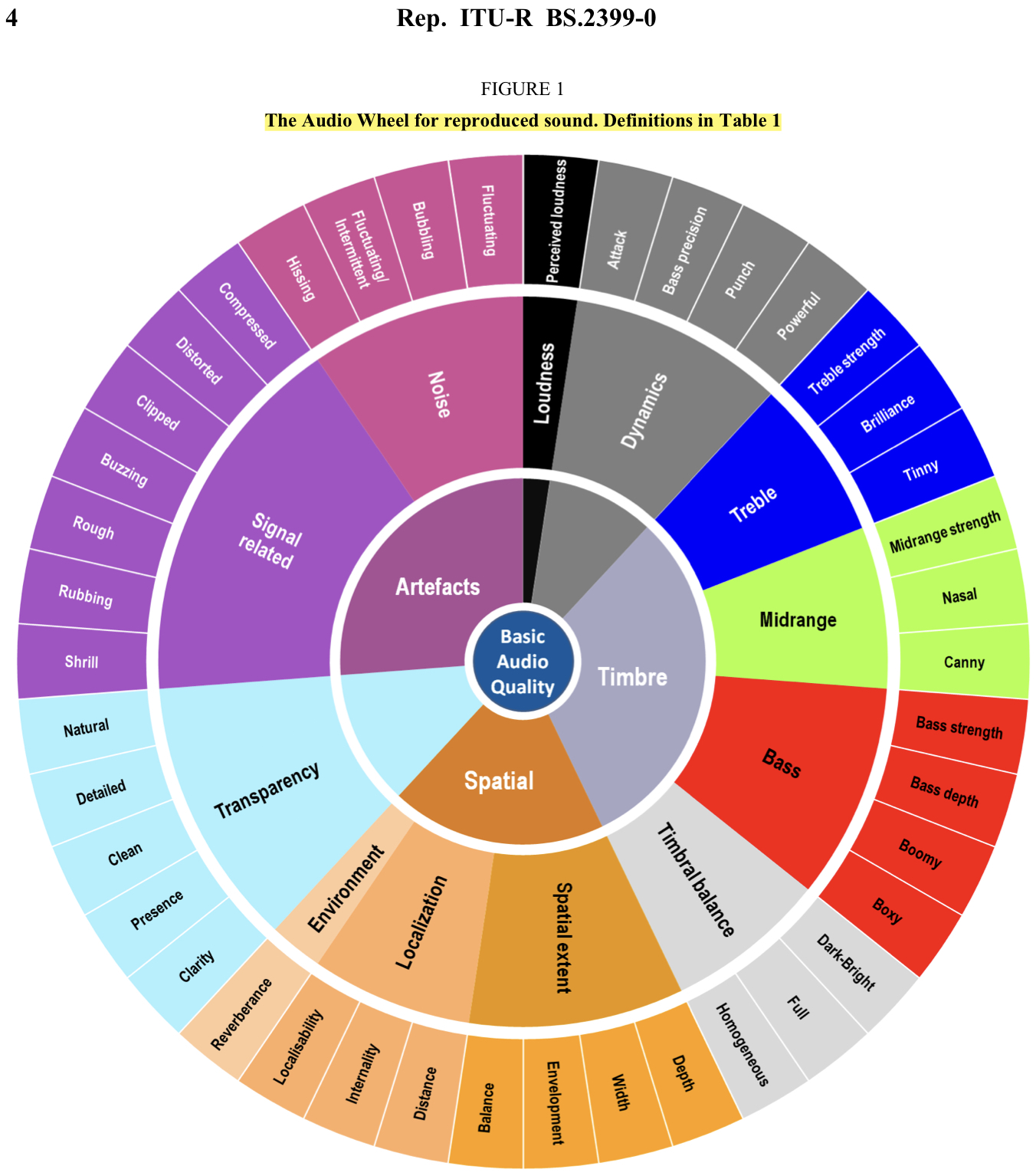
Timbre: It is helpful to think of an IEM as a filter that highlights or subdues different parts of the incoming audio signal. This effect can be measured objectively by the squiggly lines below, called Frequency Response (FR) graphs, which measure how loud an IEM is at different frequencies from 20Hz (bass) to 20kHz (upper treble). Subjectivity is how your ears and brain interpret the effect of that filter on your music and decide whether it is “enjoyable.” There are some “rules of thumb” when it comes to tonality, but most interesting IEMs usually bend the rules masterfully.
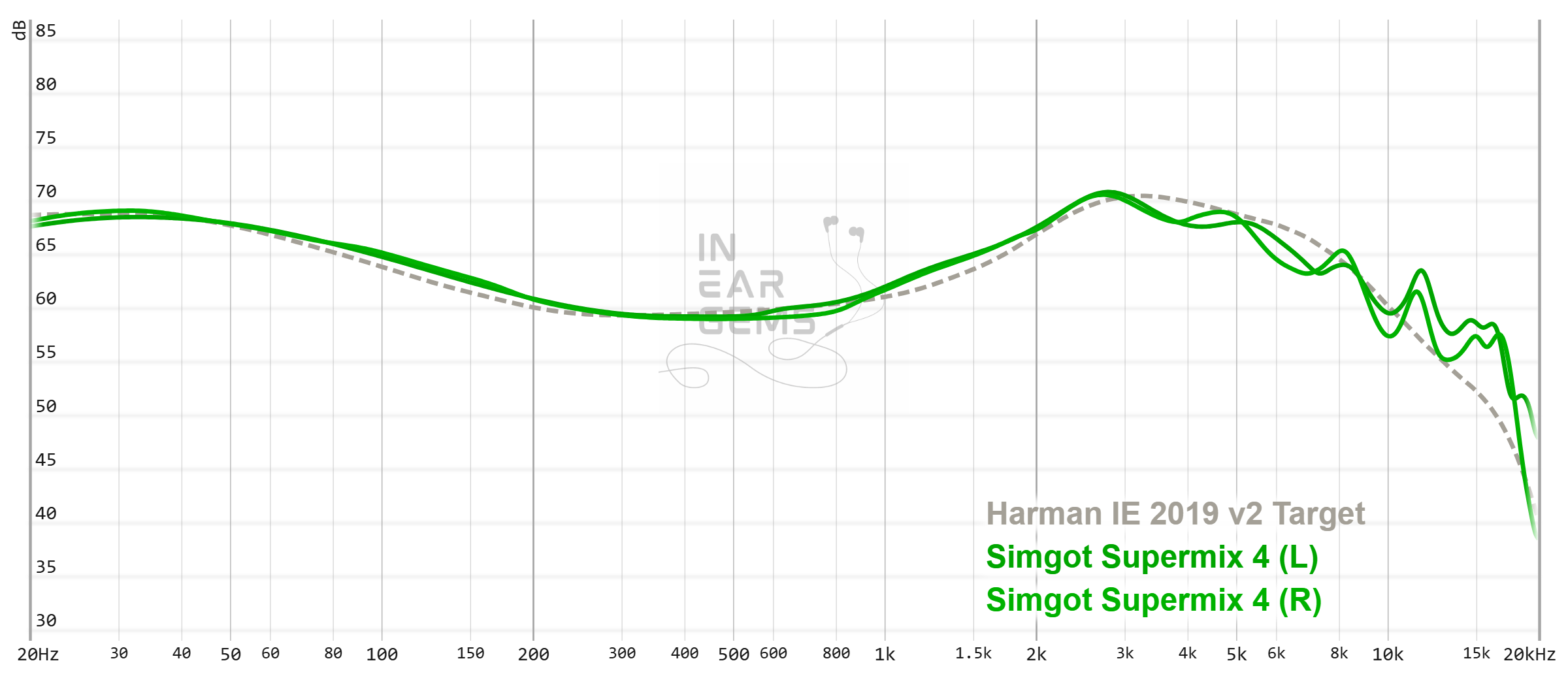
Figure shows the frequency response of Supermix4 against the Harman in-ear target. Measurements were done with an IEC-711-compliant coupler and might only be compared with other measurements from this same coupler. Above 8kHz, the measurement likely does not match the response at the ear drum. Visit my graph database for more comparisons.
Supermix4 closely follows the Harman IEM target, which can be both a blessing and a curse depending on your perspective on this frequency response goal. The overall tonal balance of Supermix4 leans slightly bright. This brightness originates from the upper midrange rather than the treble, resulting in main vocal high notes being more emphasized than cymbals, hi-hats, or sibilance when listening to rock bands.
The timbral balance across frequencies doesn’t feel entirely full or consistent due to adhering to the Harman target. The lower midrange appears scooped compared to other frequency ranges, leading to a disconnected feeling between bass and upper midrange sections. While this presentation can enhance musical clarity, it may detract from the natural energy and resonance of lower-pitched instruments and vocals.

The midrange of Supermix4, like most Harman IEMs, is highly emphasized. Vocals are loud, clear, and prominent in the mix; however, due to the imbalance between upper and lower midrange frequencies, voices exhibit a slight nasal quality. Singers seem to perform using their head or nose voice rather than their chest voice. Violins sound brittle, while cellos lack essential fundamental frequencies, giving them a low-pitched viola-like tone. When testing the IEM with Kiwi wa Boku ni Niteiru by See-Saw, an ideal track for evaluating female vocal clarity in anime music, Supermix4’s Harman-inspired tonality wasn’t optimal. Chiaki Ishikawa’s voice appeared thin and slightly nasal. Adjusting the ear-gain compensation from 10dB to 7 or 8dB could help address these issues.
It’s crucial to note two points regarding the midrange quality of Supermix4: first, superficial listening might not reveal significant tonal problems; second, these flaws are inherent in the Harman target itself, so I’m not quite picking on supermix4 and simgot here.

Supermix4’s treble section sees Simgot deviate from the Harman target by lowering the 4kHz and 6kHz frequencies. This adjustment avoids the harsh combination of a prominent 3kHz frequency with piercing 4 and 6kHz tones that afflict “true Harman” IEMs. Listening to Shivers by Ed Sheeran, which is crucial for assessing an IEM’s sibilance and midrange balance, I noticed that Sheeran’s voice was bright and shrill as expected from a Harman-tuned device. However, I did not detect any excessive ice-pick sibilance, making the track enjoyable. The cymbals and hi-hats in “Playing God” by Polyphia are neither intrusive nor piercing, while remaining detailed, sitting behind the guitars. Moreover, when listening to Synchro BOM-BA-YE by Tokyo Kosei Wind Orchestra, a track that I use to evaluate treble tonal balance and timbre by focusing on the hand claps at the beginning, and the tonal quality of all brass instruments throughout the track, I did not encounter any issues with treble performance.
Interestingly, the bass quantity of Supermix4 appears weaker than suggested by its graph. In “Playing God” by Polyphia, the kick drum isn’t as impactful or “slapping in the face” as expected; however, it still provides a noticeable thump. The quick bass lines around 02:10 are quite pleasant. One positive aspect of Supermix4’s bass performance is the presence and texture of the bass guitar within the mix. It remains detailed and textured without being overshadowed. I find myself looking for bass guitar in the mix more often.
Bass and perceived dynamic: Let’s examine the bass and perceived dynamics of Supermix4 with some test tracks. The first one is “A Reckoning in Blood” from The Ghost of Tsushima OST. I’ll focus on the crescendo at 01:10, which an ideal dynamic IEM should effectively communicate. Additionally, the beats from 02:50 need to be strong, snappy, and precise, requiring excellent control across the entire frequency range. Supermix4 does a good job with the crescendo. It builds up the impression of pressure and then releases the energy at the peak of the crescendo in a satisfying, almost startling way. The beats sound snappy and maintain a good sense of pacing. However, beats are quite strong but still feel a bit unsatisfying, as if they need a few dB. In busier sections of the track, beats in the bassline can start to “mesh” together. Still, overall, the bass is snappy, precise, with a good sense of pacing and rhythm.

The next track is “Strength of a Thousand Men (Live)” by Two Steps from Hell. I’ll pay attention to the quality bass accompanying each beat. An IEM with perfect bass handling should convey a sense of “grippiness” and texture in the bass region, making the bass line growl rather than low-pitched hum. Lastly, every beat must be snappy and incisive to capture the marching energy of this track. With this difficult track, Supermix4 faltered somewhat. The bassline lacks the strength and incisiveness to complement the rhythm carried by midrange instruments. Subjectively, the presentation of Supermix4 in this type of busy track was not particularly engaging.
In summary, Supermix4 has relatively clean transient attacks and precision. Bass can have good texture. Music that relies on subbass to convey energy can feel quite powerful. However, because Supermix4 emphasizes subbass over midbass, the sense of punchiness is not quite prominent. Overall, I consider the bass and dynamic of Supermix4 to be quite good, in both tuning and bass quality; though not quite a standout feature (3.5/5).
Resolution: To me, “resolution” can be broken down into three components: (1) Sharpness, incisiveness, or “definition” of note attacks (see the figure above). (2) The separation of instruments and vocals, especially when they overlap on the soundstage. (3) The texture and details in the decay side of the notes. The first two give music clarity and make it easy to track individual elements of a mix. The last provides music details and nuances.

Let’s elaborate on the resolution of Supermix4 with some test tracks. For the first track, we listen again to Ciaccona from Bach’s Violin Partita No. 2 in D Minor, performed by Kavakos. I focus on the micro details such as the bow catching the strings. I also focus on the quality and nuances of the reverberation and decays of the notes. Supermix4 does a great job with this recording: violin’s presentation has a “dry”, grippy sensation that reveals quite a bit of micro details, and the reverberation of the recording hall is highlighted. In direct comparison against Blessing 2 (my reference for 3/5 resolution class) and Andromeda 2020 (my reference for 4/5 resolution class), I found that Supermix4’s resolution is much closer to the latter than the former. In A/B comparison, I found that Blessing 2 lacks the reverberation and the violin strings sound more simplistic and less textured. I still find the Andromeda 2020 to have a slight edge over the Supermix4, but I would attribute this to the difference in tonality (i.e., because Andromeda has more lower midrange, information in that part is revealed more than the Supermix4).

The next track is the “controlled chaos” ABC feat. Sophia Black by Polyphia. With this track, I focus on an IEM’s ability to not crumble under the complexity of overlapping layers in the mix. An IEM with ideal resolution would make it easy for me to hear everything, down to the very faint overdub by Sophia Black on the side channels right from the opening of the track. Again, I found that Supermix4 does a great job. In busy sections of the track, the Blessing 2 does not separate overlapping elements as cleanly as Supermix4, so the music sounds a touch more mushy with Blessing 2 than Supermix4. The overall instrument separation and detail retrieval of Supermix4 is quite close to the Andromeda 2020 in this track.
In summary, I find that the Supermix4 has a clean presentation that highlights midrange information with good sense of clarity (as one would expect from an IEM tuned toward the Harman target). The detail retrieval, particularly the reverberation and background elements of the mix, are quite good thanks to the good treble extension. However, I think the Harman tuning does hurt the perceived detail retrieval of Supermix4 as it pulls the information from the upper bass and lower midrange region back. In conclusion, I consider the resolution of Supermix4 to be “Great” (4/5).
Stereo imaging and soundstage: Stereo imaging or “soundstage” is a psychoacoustic illusion that different recording elements appear at various locations inside and around your head. Your brain creates based on the cues in the recording, which are enhanced or diminushed by your IEMs, your DAC, and your amplifier. In rare cases, with some specific songs, some IEMs can trick you into thinking that the sound comes from the environment (a.k.a., “holographic”)

Let’s listen to some test tracks to assess the soundstage and imaging capabilities of Supermix4. The first one is Original Sound Effect Track - Memory from Gundam Seed Destiny OST album. This track compiles all sound effects used in the show, arranged atmospherically and immersively. An IEM with ideal soundstage and imaging should effectively utilize this information to create a diverse soundstage, with sound elements appearing in all three dimensions, offering contrast between near and distant sounds. Many elements on the left and right channels will seem to originate outside the ears. Supermix4 does an outstanding job with this track: spacious, immersive, and quite holographic. The presentation of musical elements in the mix, such as the brass in the beginning, are particularly impressive: Supermix4 pushes them outside the headstage and creates a convincing illusion that they are sounds coming from the surrounding environment. The sound effects in the middle convey a good sense of separation and forward-backward positioning.
In A/B comparison, I found that the soundstage presentation of Supermix4 is noticeably more spacious and more 3D than that of Blessing 2 (reference for 3/5 soundstage). I also found that the soundstage of Supermix4 is more open, with the background of the soundstage projected further into the background than Andromeda 2020 (reference for 4/5 soundstage). In fact, in terms of the projection of the background elements, Supermix4 is quite similar to the U12T (my reference for 5/5 soundstage). The U12T has a noticeable edge in terms of the nuance and 3D illusion of instrument placement in the center of the stage. Moreover, the center of the soundstage on U12T is less in-the-head than Supermix4.

The next track is Shadow of Baar Dau. This one tests an IEM’s ability to convincingly convey the sense of distance of background elements, such as the string section at 00:20 on the front left and the vocal chants on the front right at 00:40. An IEM with perfect soundstage and imaging should make this track feel spacious, creating an illusion that some background elements originate outside the head. In essence, it should provide a fully immersive listening experience. Again, Supermix4 does an excellent job with the soundstage and imaging of this track. When comparing against Andromeda, I found that the Supermix4 actually conveys the distant background elements of the mix in a more special and holographic manner than the Andromeda, though the main actions happening at the center of the stage sounds more spread out with the Andromeda rather than mostly in-the-head with the Supermix4. Against U12T, the same observations from the previous track hold. Supermix4 trades blows with U12T in terms of pushing the background elements outside the headstage into the surrounding environment. However, U12T has a clear edge in precision and “3D-ness” of the instrument placement in the center part of the stage, and the center of the stage feels less in-the-head than Supermix4.
In summary, I found that Supermix4’s soundstage and imaging capabilities are rather special. Taken as a whole, the soundstage has quite good width, depth, and height. The soundstage feels open. Supermix4 can convey the uncanny, holographic placement of background elements in the track that not many IEMs can do. Supermix4 can convey the reverberation information in the track pretty well as well. The most significant problem of Supermix4 is likely due to the Harman-tuning, which makes the foreground of the soundstage tightly focused around a phantom center inside the head. This tight focus can make the “in-the-head” sensation overpowering the interesting holographic effect that Supermix4 can convey. Still, I would consider the soundstage and imaging capability of Supermix4 as 4.5/5 - Great.
Driveability
Supermix4 exhibits noticeable differences in sound when connected to various source chains. Even paired with the humble Apple USB-C to 3.5mm adapter (the “Apple dongle”), this IEM can produce ample volume. However, the resulting audio quality is underwhelming: the mix feels congested and lacks clarity, while note definition and instrument separation across the frequency range appear muted. Despite offering a sufficient amount of bass, the transient response fails to deliver a crisp impact. Furthermore, Supermix4’s ability to create a holographic listening experience is diminished with this particular pairing.
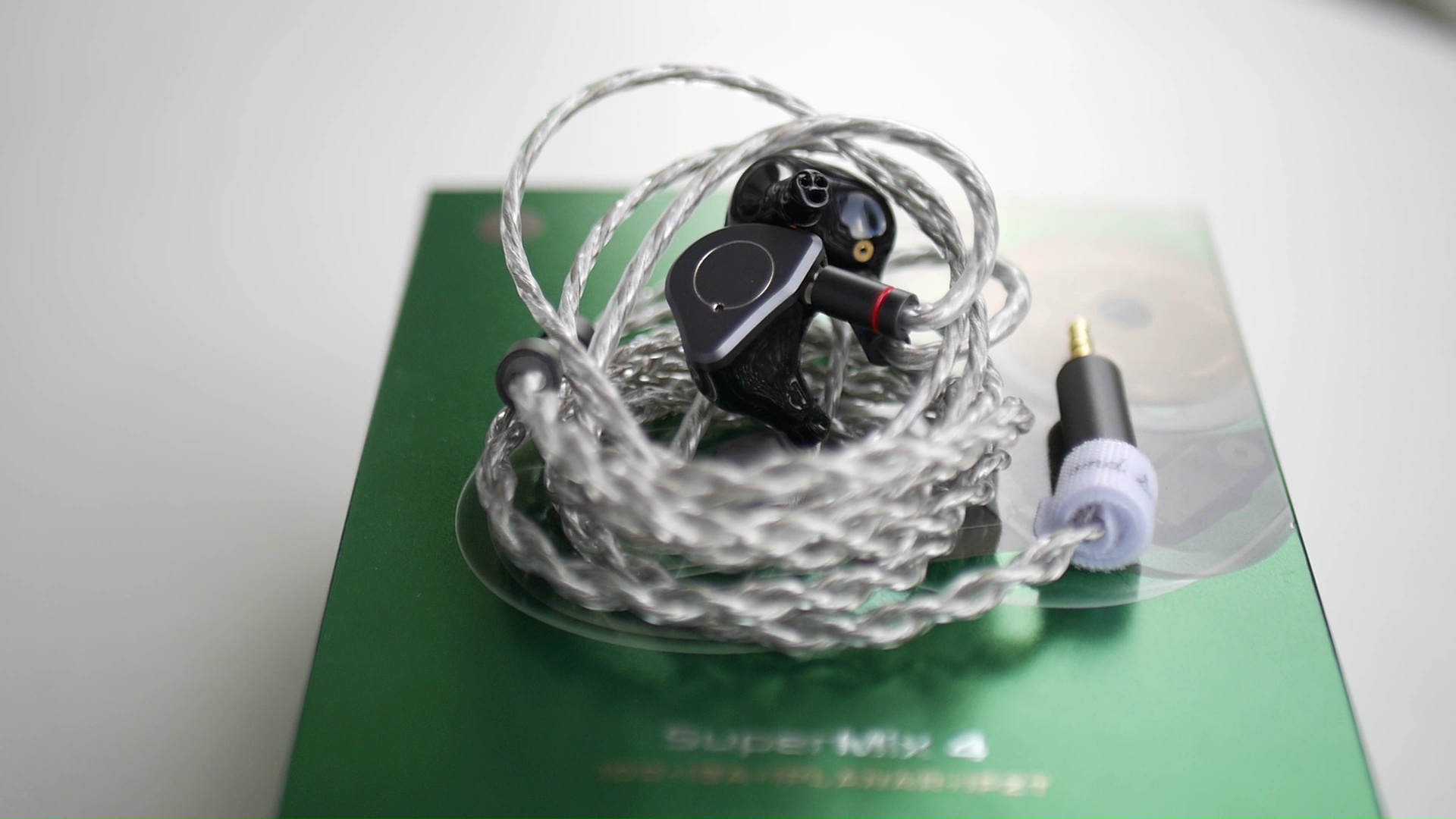
Switching to the 4.4mm output on R3II significantly enhances the soundstage presentation, providing clearer instrument definition and lessening the congested middle-ground feel. The IEM’s holographic quality returns as background elements gain separation. Upgrading to DX300 unveils another layer of Supermix4’s sonic potential, though the improvement feels more like a refinement than a significant leap. The stage remains open with fewer crowded central instruments, and background details become even more distinct. Bass transient response also gains a slight boost in crispness.
Personally, I would pair Supermix4 with a quality USB DAC or a compact DAP such as R3II. The Apple dongle and laptop output would be reserved for emergency use only, like during online calls.
Comparisons
Vs Simgot EM6L “Phoenix”: While Supermix4 and EM6L share a similar tonality, following the Harman frequency response target, there are notable differences: (1) EM6L exhibits more treble spice, particularly evident in tracks like Shivers by Ed Sheeran due to sibilance and harshness. (2) The midrange region between 800Hz and 3kHz of EM6L appears thinner than that of Supermix4, leading to a weak, wispy sound on higher notes such as the A string and E string of a violin. (3) Supermix4’s upper treble extension outperforms EM6L, demonstrated by the presence of reverberation absent in the latter.
Both IEMs feature concentrated soundstages around the phantom center; however, only Supermix4 delivers a holographic effect for background elements. Bass performance differs as well, with Supermix4 offering more pronounced and satisfying beats compared to EM6L. Overall, I consider Supermix4 an upgrade over EM6L.

Vs Simgot EA1000 “Fermat”: The tonal characteristics of Supermix4 and EA1000 are nearly identical, except for a key distinction: EA1000 provides additional energy around 250Hz, resulting in more balanced and natural vocals and violins. Conversely, the upper treble extension of Supermix4 outshines that of EA1000.
Soundstage experiences are comparable between the two IEMs, with Supermix4 offering an expanded background and stronger holographic effect for distant elements. The bass response is more satisfying on Supermix4 due to its snappier transient response. Lastly, resolution is higher on Supermix4 than on EA1000.
Conclusions
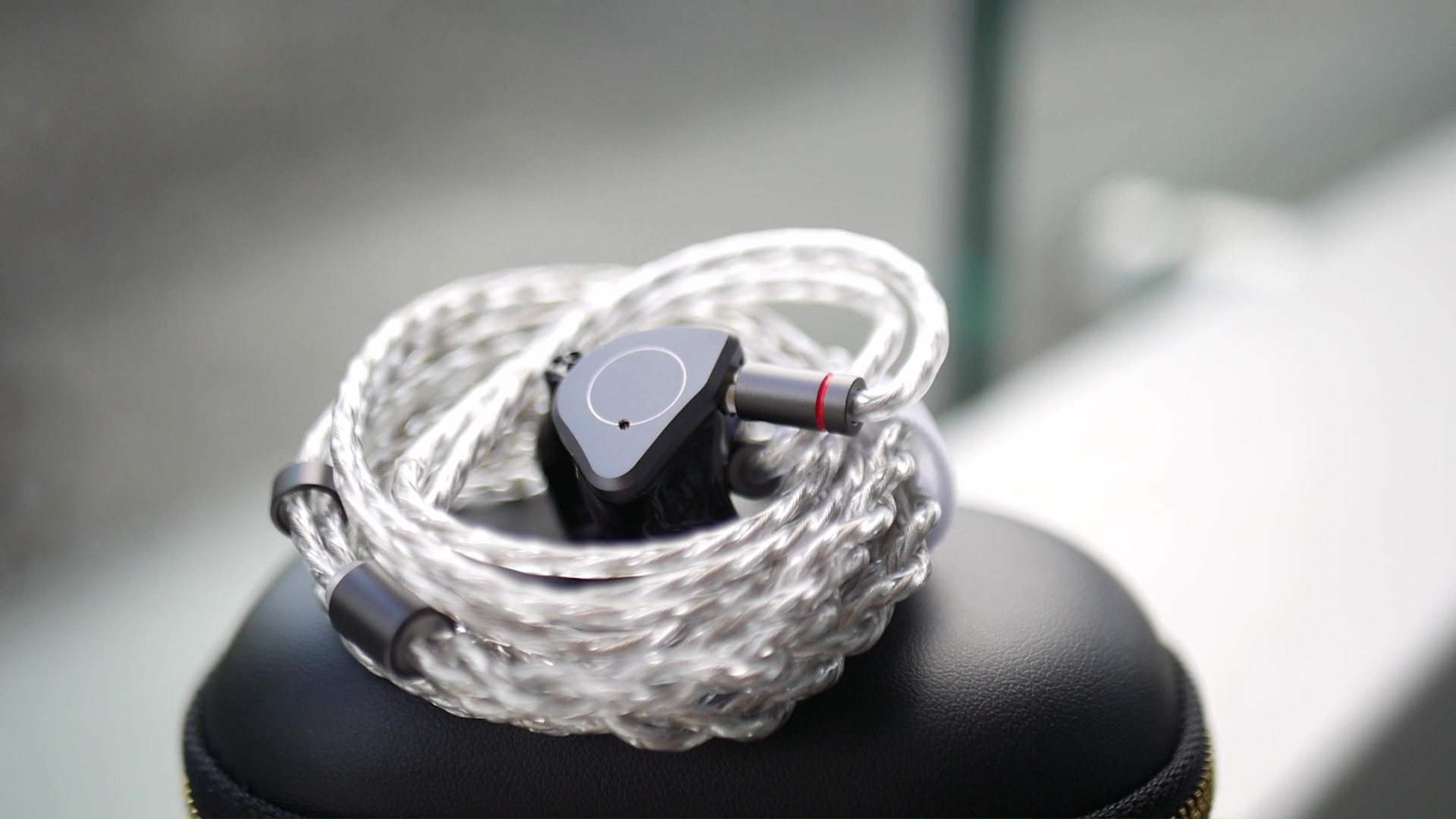
As my review of Supermix4 draws to a close, I find myself experiencing mixed emotions. On one hand, I am excited and impressed by its performance, as Supermix4 meets my expectations for an IEM with a quad-brid driver topology. In direct comparison to its single-driver and hybrid siblings, Supermix4 excels in technical performance while offering unique soundstage presentation. On the other hand, I can’t help but feel some disappointment due to certain weaknesses that could have been addressed through minor tuning adjustments. A slight deviation from the Harman IE 2019 target might resolve issues of the nasal, thin tonality affecting vocals and instruments. Lowering ear-gain compensation from 10dB to a more suitable 7-8dB could address the in-the-head placement of the soundstage, thus further highlighting the holographic effect of background elements within the soundstage.
So, should you consider purchasing Supermix4? Your answer depends on your personal opinion of the Harman IE2019 target. This decision shouldn’t be influenced by others’ views but rather based on your own experiences listening to IEMs that strictly adhere to this tuning. How well do your music library and preferences align with the tonal characteristics of the Harman IE2019 target? Are you able to appreciate its sound or do you notice any issues? If you find the Harman IE2019 target appealing or remain indifferent toward it, Supermix4 receives a recommendation by this reviewer.
What I like about this IEM:
- Strictly Harman-tuned tonality! (If you like Harman)
- Clean and clear presentation with strong sense of clarity
- Good instrument separation
- Good detail retrieval
- Expansive, even holographic soundstage with right tracks
- Comfortable fit
What could be improved:
- Strictly Harman-tuned tonality …
- Instruments are mostly distributed around the phantom center inside the head
- Bass could be punchier
Absolute Sonic Quality Rating: 4/5 - Great
Bias Score: 4/5 - I like this IEM
